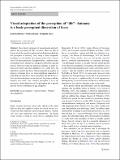Visual adaptation of the perception of “life”: Animacy is a basic perceptual dimension of faces
Author(s)
Koldewyn, Kami; Hanus, Patricia; Balas, Benjamin
Download13423_2013_Article_562.pdf (595.4Kb)
PUBLISHER_POLICY
Publisher Policy
Article is made available in accordance with the publisher's policy and may be subject to US copyright law. Please refer to the publisher's site for terms of use.
Terms of use
Metadata
Show full item recordAbstract
One critical component of understanding another’s mind is the perception of “life” in a face. However, little is known about the cognitive and neural mechanisms underlying this perception of animacy. Here, using a visual adaptation paradigm, we ask whether face animacy is (1) a basic dimension of face perception and (2) supported by a common neural mechanism across distinct face categories defined by age and species. Observers rated the perceived animacy of adult human faces before and after adaptation to (1) adult faces, (2) child faces, and (3) dog faces. When testing the perception of animacy in human faces, we found significant adaptation to both adult and child faces, but not dog faces. We did, however, find significant adaptation when morphed dog images and dog adaptors were used. Thus, animacy perception in faces appears to be a basic dimension of face perception that is species specific but not constrained by age categories.
Date issued
2013-12Department
McGovern Institute for Brain Research at MITJournal
Psychonomic Bulletin & Review
Publisher
Springer US
Citation
Koldewyn, Kami, Patricia Hanus, and Benjamin Balas. “Visual Adaptation of the Perception of ‘life’: Animacy Is a Basic Perceptual Dimension of Faces.” Psychonomic Bulletin & Review 21.4 (2014): 969–975.
Version: Author's final manuscript
ISSN
1069-9384
1531-5320